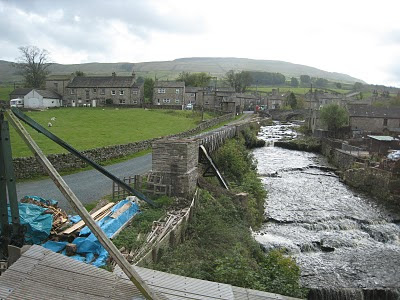


 We were utterly blown away by our visit to Gayle Mill in October. It is a fascinating place. It takes about 45 minutes to drive in leisurely fashion from Laykin and is just outside Hawes. On Sunday mornings you can have a tour and see all the machinery in the old waterpowered mill working to cut and turn wood. You can see one of the only working Victorian turbines still in situ and still working long after the modern ones which were brought in to replace them have broken!
We were utterly blown away by our visit to Gayle Mill in October. It is a fascinating place. It takes about 45 minutes to drive in leisurely fashion from Laykin and is just outside Hawes. On Sunday mornings you can have a tour and see all the machinery in the old waterpowered mill working to cut and turn wood. You can see one of the only working Victorian turbines still in situ and still working long after the modern ones which were brought in to replace them have broken!On other days you can have a guided tour and see a couple of things in action - still just as good.
The mill featured on Restoration on TV in 2004 and almost won. Shame it didn't- it is a jewel of a place, and gets brought to life by the enthusiasm of its volunteers.
From their website www.gaylemill.org.uk, I have copied the following
On Daily Guided Tours you will :
| |
| On one of our special two hour Demonstration Tours you will experience all aspects of a “Daily Guided Tour” described above and also see and hear the original 1879 water-powered Victorian machinery being demonstrated. Booking is strongly advised. HISTORY Gayle Mill was built in 1784 by two related entrepreneurs, Oswald and Thomas Routh, who saw the business opportunities opened up by the building of a turnpike road from the west and the end of the American War of Independence which allowed a greater flow of raw cotton from the United States. It started life as a cotton-spinning mill, powered by a 22' diameter overshot waterwheel, and over the next century, as economic conditions in the Dales changed, was also used for spinning flax (briefly) and then wool for the local knitting cottage industry in the valley. For a period in the 19th century, it was used for domestic accommodation (and it also housed military personnel during World War II) In 1879 the Mill took on a new lease of industrial life when, due to advances in technology, it was converted it into a mechanised sawmill. The waterwheel was removed and replaced with a Thomson double-vortex turbine, built by Williamsons (now Gilbert Gilkes & Gordon Ltd) of Kendal. The 10hp (7.46kW) created by the turbine drove a range of woodworking machinery (rack sawbench. circular saw, planner/thicknesser, and lathes) by a series of belts and pulleys off a central line-shaft. In the early years of the 20th century, an electric generator was installed to provide lighting and from 1920 the Hawes Electric Company leased part of the Mill and turbine for their own generator. A gas engine (now removed) was also installed to be able to drive the generator when there was insufficient water to run the turbine. In 1925 a second turbine was put in to create greater capacity. In 1959 all electricity supplies from the Mill to the outside world ceased, leaving the 1925 generator to supply all electrical requirements for just the Mill. The Williamson turbine continued to supply the motive power for the woodworking machinery until the business closed down in 1988. It took four long years of work to restore this treasure to its former glory. |

No comments:
Post a Comment